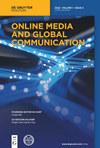Mobile app adoption comparison between U.S. and Chinese college students: information processing style and use frequency after download
引用次数: 0
Abstract
This study examines similarities and differences in information processing of college mobile app adopters, as age peers, in China and the U.S., by using the heuristic-systematic model as the main theoretical framework. An online self-administered survey was conducted. The results confirm that some peripheral factors affect personal factors. Some cultural orientations (power distance, indulgence, individualism, and uncertainty avoidance) influence app adopting behavior indirectly via information processing. Social norms significantly predict information processing and adopting behavior. Respondents share similar heuristic processing but show significant differences in systematic processing, which results in significantly different adopting behaviors. Some cultural orientations affect app adopting behavior through information processing, but affect heuristic processing and systematic processing differently. Not all cultural orientations influence the decision-making process, and some orientations may be moderators instead of predictors. Social norms can create strong social motivation in app adoption. Respondents are capable of processing information so perceived behavioral control is not a significant influencer in the decision-making of app adoption. Respondents are different in systematic processing but not in heuristic processing, which calls attention to cross-cultural comparisons in terms of information processing, researchers should test at the dimensional or item level before comparing at the variable level. This study extends the heuristic-systematic model by connecting peripheral factors (national culture, social norms, and perceived behavioral control) and personal factors (information processing and behavior). This study also tests the special roles of social norms and perceived behavioral control, which originated from the theory of planned behavior, as peripheral factors, and enriches the literature on information processing of decision-making. This study introduces the possibility that respondents are more different in systematic processing than heuristic processing and cultural orientations affect heuristic processing and systematic processing in different ways, and also sheds light on technology acceptance literature in terms of non-adoption.中美大学生使用手机应用的比较:信息处理方式和下载后的使用频率
本研究以启发式系统模型为主要理论框架,探讨了中美两国大学生作为同龄人在信息处理方面的异同。 研究人员进行了在线自填式调查。 结果证实,一些外围因素会影响个人因素。一些文化取向(权力距离、放纵、个人主义和不确定性规避)通过信息处理间接影响了应用采纳行为。社会规范对信息处理和采用行为有明显的预测作用。受访者具有相似的启发式处理方式,但在系统化处理方面却表现出显著差异,这导致了明显不同的采用行为。 某些文化取向通过信息处理影响应用程序的采用行为,但对启发式处理和系统性处理的影响不同。并非所有的文化取向都会影响决策过程,有些文化取向可能是调节因素而非预测因素。社会规范可在应用程序采用过程中产生强大的社会动力。受访者有能力处理信息,因此感知行为控制并不是影响应用决策的重要因素。受访者在系统处理方面存在差异,但在启发式处理方面没有差异,这就要求在信息处理方面进行跨文化比较时,研究人员应先在维度或项目层面进行测试,然后再在变量层面进行比较。 本研究将外围因素(民族文化、社会规范和感知行为控制)与个人因素(信息加工和行为)联系起来,从而扩展了启发式-系统式模型。本研究还检验了源于计划行为理论的社会规范和感知行为控制作为外围因素的特殊作用,并丰富了有关决策信息处理的文献。本研究提出了一种可能性,即受访者在系统化处理方面的差异大于启发式处理,文化取向以不同方式影响启发式处理和系统化处理,同时也从非采纳方面为技术接受文献提供了启示。
本文章由计算机程序翻译,如有差异,请以英文原文为准。
求助全文
约1分钟内获得全文
求助全文
来源期刊

Online Media and Global Communication
Communication, Media Studies, Internet Studies, International Studies, International Relations-
自引率
0.00%
发文量
0
期刊介绍:
Online Media and Global Communication (OMGC) is a new venue for high quality articles on theories and methods about the role of online media in global communication. This journal is sponsored by the Center for Global Public Opinion Research of China and School of Journalism and Communication, Shanghai International Studies University, China. It is published solely online in English. The journal aims to serve as an academic bridge in the research of online media and global communication between the dominating English-speaking world and the non-English speaking world that has remained mostly invisible due to language barriers. Through its structured abstracts for all research articles and uniform keyword system in the United Nations’ official six languages plus Japanese and German (Arabic, Chinese, English, French, Russian, Spanish, Japanese, and German), the journal provides a highly accessible platform to users worldwide. Its unique dual track single-blind and double-blind review system facilitates manuscript reviews with different levels of author identities. OMGC publishes review essays on the state-of-the-art in online media and global communication research in different countries and regions, original research papers on topics related online media and global communication and translated articles from non-English speaking Global South. It strives to be a leading platform for scientific exchange in online media and global communication.
For events and more, consider following us on Twitter at https://twitter.com/OMGCJOURNAL.
Topics
OMGC publishes high quality, innovative and original research on global communication especially in the use of global online media platforms such as Facebook, TikTok, YouTube, Twitter, Instagram, WhatsApp, Weibo, WeChat, Wikipedia, web sites, blogs, etc. This journal will address the contemporary concerns about the effects and operations of global digital media platforms on international relations, international public opinion, fake news and propaganda dissemination, diaspora communication, consumer behavior as well as the balance of voices in the world. Comparative research across countries are particularly welcome. Empirical research is preferred over conceptual papers.
Article Formats
In addition to the standard research article format, the Journal includes the following formats:
● One translation paper selected from Non-English Journals that with high quality as “Gems from the Global South” per issue
● One review essay on current state of research in online media and global communication in a country or region
 求助内容:
求助内容: 应助结果提醒方式:
应助结果提醒方式:


